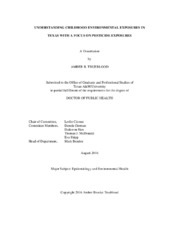| dc.description.abstract | Through five studies, this dissertation expands our understanding of pesticide exposures and evaluates one intervention for reducing these exposures. The first study assessed the impact of environmental health trainings that addressed multiple exposures for Head Start employees and parents in Webb County, TX. Pre- and post-assessments found significant improvements in knowledge and self-reported behaviors. The remaining studies focused on pesticide exposures. Available literature on pesticide exposures is limited, despite being the eighth most common substance category reported in 2014 to poison centers nationally for children ≤5 years. To fill gaps in the literature, pesticide exposures in children were characterized through descriptive statistics and prevalence calculations for pesticide-related hospitalizations (N=158) and poison center exposures (N=61,147) for children ≤ 19 years in Texas. Males and younger children had a higher prevalence of unintentional exposures, while adolescents had a higher prevalence of intentional exposures. The comparison of hospitalization and poison center data identified trends between the datasets, and discussed dataset strengths and limitations. Finally, an exploratory spatial scan analysis identified primary clusters for unintentional pesticide-related exposures. Descriptive statistics, significance tests, and logistic regression models were used to identify factors associated with clusters of unintentional pesticide-related poison center exposures in children ≤19 years. As the percentile increased for percent black or African American population, the probability of being a cluster county decreased, and as the percentile increased for the percent of the population that had moved in past 12 months, the probability of being a cluster county increased. Lastly, negative binomial regression models identified factors associated with prevalence of unintentional pesticide-related poison center exposures in children ≤19 years. Increasing percentile of American Indian or Alaska Native population was associated with decreased prevalence, and increasing percent of structures built before 1939 was associated with an increased prevalence. This dissertation quantified childhood pesticide exposures and identified related variables. Future research should utilize additional secondary datasets (e.g. cancer registries, mortality data, and emergency room data), and may benefit from the execution of more advanced study designs (e.g. case-control and cohort) that can address the limitations of this dissertation, such as identifying health effects associated with pesticide exposures. | en |


